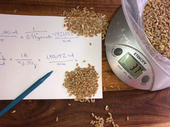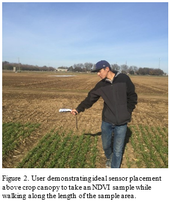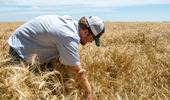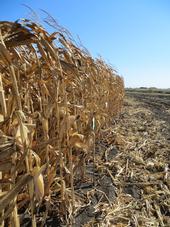- Author: Taylor Nelsen
- Author: Gabriel Rosa
- Author: Justin Merz
- Author: Mark Lundy

Weather patterns are highly variable across the state of California. They change from year to year and across locations. While parts of the state may be experiencing drought conditions this year (Figure 1), each location can have dramatically different weather. For growers and agronomists, location-specific weather information is essential to understand plant growth and water use. It is also important for planning field management activities such as fertilization and irrigation.
We have created a new interactive website where users can access their location-specific precipitation and temperature data:
- Author: Konrad Mathesius
- Author: Taylor Nelsen
- Author: Mark Lundy

Seeding rate is an important consideration for small grain growers at planting. There are a number of agronomic factors that help to determine the ideal seeding rate such as whether a field will be irrigated, the potential for weed pressure or lodging, the planting date, crop type, and seed germinability. In addition, there can be a large range of seed weights among different small grain varieties and from one seed lot to the next. To achieve full yield potential under irrigated conditions in California, 25 to 30 plants per square foot is a good target density for wheat. As a seeding rate this translates to approximately 1.2 million seeds per acre with a seed weight of 40 gram per thousand seeds. However, adjustments to the seeding...
- Author: Nicholas Clark
- Author: Thomas Getts
- Author: Giuliano C. Galdi
- Author: Taylor Nelsen
- View More...

This is the third post in a blog series focused on improving nitrogen (N) use efficiency in California small grains. This post discusses two hand-held devices that indicate plant N levels in small grains to help optimize fertilizer decisions. The tools help determine plant vigor by measuring light reflected from the whole plant canopy or absorbed by a single leaf. Comparing measurements made in and immediately outside of N rich zones in representative areas of the field helps determine if the crop is likely to respond to more N fertilizer. The plant N levels indicated by the hand-held devices complement other important information, which are...
- Author: Caroline Brady, Waterfowl Programs Supervisor, California Waterfowl
- Contributor: Mark Lundy

Winter grains like wheat and triticale are incredibly attractive to nesting ducks. Winter grains are seeded in the fall and grow throughout the winter; by nesting season, a dense stand of winter grains near a planted rice field looks like a great nesting location with brood-rearing habitat just a waddle away. Several studies have found ducks may favor winter planted grains over natural uplands when they're available, and winter grains in rice country can produce far higher mallard nest densities and nest survival than anything in the Prairie Pothole Region.
Unfortunately, some winter grains like wheat have been declining along with its poor market price, and the Sacramento Valley's once robust mallard population is declining...
- Author: Michelle Leinfelder-Miles

UC Cooperative Extension will host the annual corn field meeting on Tuesday, October 15th, from 10:00-11:30am, on Tyler Island in Sacramento County. The agenda is pasted below and attached. In addition to providing information on the annual corn variety trial, this year's agenda includes presentations on nitrogen management for the upcoming small grains season. The attached version of the agenda includes a map and directions to the field site. We have applied for CCA continuing education credits, and light refreshments will be provided. RSVP is not required. Hope to see you in the field!
Agenda:
10:00am Field corn...



